Styles of paws in furry art
Start page | Paws in art |
Better be barepawed |
Comic strip |
List of freepawers
A lot of different styles for paws exist in furry art. The range goes from
true digitigrade animal paws to almost-human feet (with toenails and
furless soles), and there are a lot of nice styles inbetween. This page
discusses some of the decisions that a furry artist or player has to make,
and shows some examples on how to draw paws. Keep in mind that paws are an
important way of expressing a furry's personality, mood and species.
Hindpaws (footpaws)
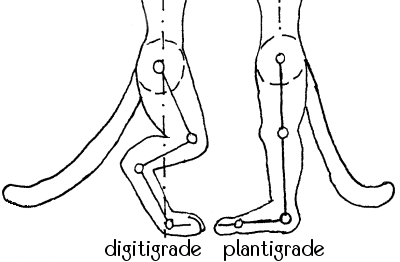
Leg shape: Digitigrade or plantigrade?
The first thing to decide when drawing (or designing a furry character
concept) would be the leg shape. Digitigrade legs have their heels off
the ground, which has an effect for the entire leg - it usually cannot
be stretched out, the whole character has a more dynamic position and
would probably have trouble keeping balance when standing still on two
legs. Plantigrade legs can be quite humanoid in proportions, so they
can be stretched out totally, leading to a completely upright standing
position.
When drawing digitigrade paws, take into account that these have to
carry the whole weight if the furry is on two legs, so draw them
bigger than they would be if the furry was on four legs. It is also
important to find the right "balance": when standing, the center of
gravity should be vertically above the paws. The picture compares
digitigrade and plantigrade legs, you can see the "line of gravity"
on the digitigrade furry.
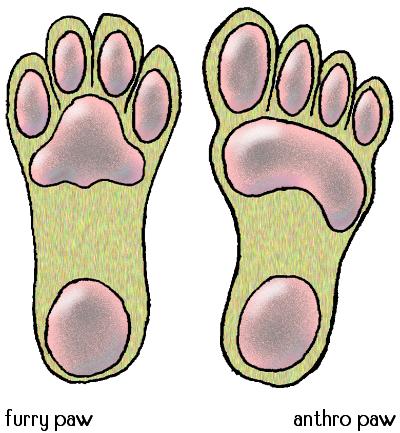
Toes: how many, which shape?
Many artists give their furries the same number of toes as the
corresponding animal would have in real life. Some, especially those
with a more "toonish" style, reduce the number of toes to three; others
(those with a highly anthropomorphic style) give all furries five toes,
regardless of species.
The front part of the foot can be rounded like a furry paw or have a
pronounced big toe as humans have it (or anything inbetween). The
picture shows two different plantigrade paws with pads - the one on
the left (symmetric) is based on a feline paw, with the addition of a
heel pad; the one on the right is more anthropomorphic in shape, with
a big toe as humans have them (but only four toes). As often in furry
art, this paw is wider and shorter than human feet would usually be.
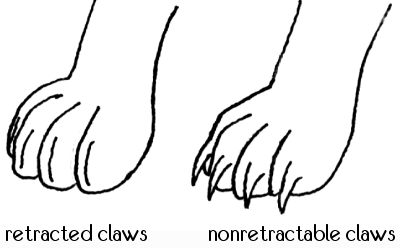
Claws
Some artists give their furries realistic claws (for example, strong
fixed claws for canine species, sharp retractible claws for felines).
The claws of felines are usually retracted unless in use (when
holding on to something, climbing, stretching, scratching, attacking).
In that case, the clawsheaths on the toetips are visible, perhaps with
a bit of the clawtips. Toonish paws often have no visible claws at all
(or claws only if they are in use, as a form of expression, but
normally completely invisible). A few artists even give their furries
humanoid toenails - this usually in combination with the aforementioned
"big toe" configuration.
The picture on the right compares two digitigrade paws - on the left
(feline), the claws are retracted (the clawsheaths appear as vertical
lines on the toes); the right has nonretractable claws and might
belong to a cheetah or canine.
Soles: padded, furry or furless?
Furry paws often, but not always, have pads of tough, furless skin,
giving them good traction and optimal sensitivity. Each toe has an oval
pad, the center of a digitigrade paw is formed by a big pawpad which
is differently shaped, according to the species. If a furry artist
draws a plantigrade footpaw which looks like a digitigrade paw in
front, usually a heel pad is added (as that carries a good part of the
weight in plantigrade paws). Some artists however omit the heel pad,
so that the furry "walks on fur" (often such paws are semi-digitigrade:
walking digitigrade, but using heels for support when standing). See
Akai's example below for one way to do it. (By the way, furries who
walk barefoot a lot in real life will experience that their feet
develop pronounced pads, including the heelpad, much like a furry paw!)
Another approach is to omit the pads and give the paws a smooth
surface with the same colour of the rest of the fur. See Toma's
example of "plush paws" below.
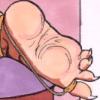
Some artists give their furries completely furless soles, without
pronounced pads - this is again a sign of high anthropomorphism.
The picture on the right (by MouseHouse) shows an example of this
style.
Fuzzyness
Depending on the species, you can either add a lot of fur (for
species adapted to coldness, such as polar bears or snow leopards)
especially around and between the toes, or have rather sparsly furred
paws (as many rodents have them).
Forepaws (handpaws)
Opposable thumbs
The paws of many four-legged species are not very well suited for
holding objects. So, a two-legged furry usually has more "hand-shaped"
paws to be able to grab objects. A number of species already have the
right paw shape for this.
Fingers - how many, how long?
Once again, toons often have a smaller number of fingers -
four-fingered handpaws can often be seen (easier to draw?), even
three-fingered handpaws, though this tends to look rather strange.
Five-fingered handpaws, just as the forepaws of all felines for example
are five-fingered, are still widespread.
Another tendency for furry handpaws is to make the fingers shorter than
human fingers would be. For cats especially, it has to be like this if
the fingerclaws should still be retractable.
Claws and pads
Usually the configuration of claws and pads is the same on the forepaws
and hindpaws of a given furry - though the pads on the handpaw fingers
of exclusively two-legged furries are usually not as tough, as they are
not walking on them.
Examples
How to draw a furry footpaw - by Akai
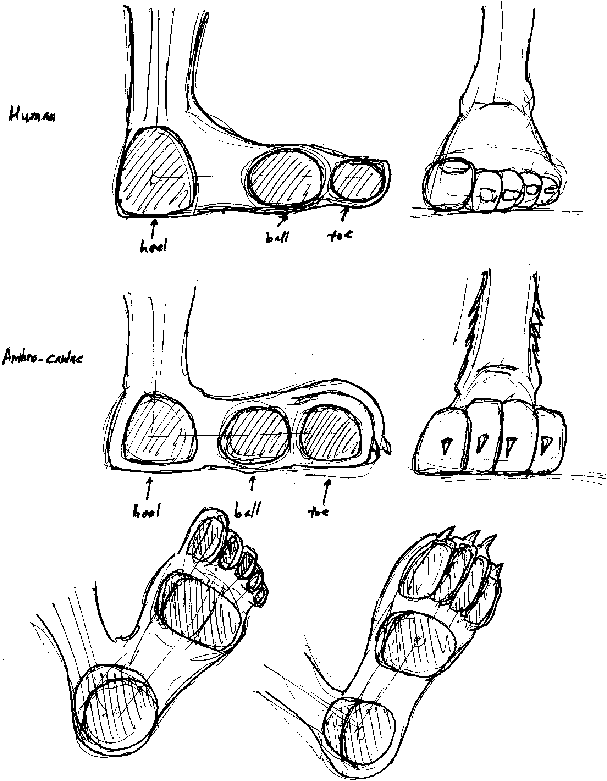
Akai compares in this drawing
the plantigrade footpaw of an anthro-canine to a human foot. As a help
for drawing, the foot is divided into ovoid volumes for the heel, the
ball and the toes (which are corresponding to the pads on the furry
paw). You can see the difference in proportions: the toes of the furry
paw are bigger and all of about the same size.
Plush paws - by Toma
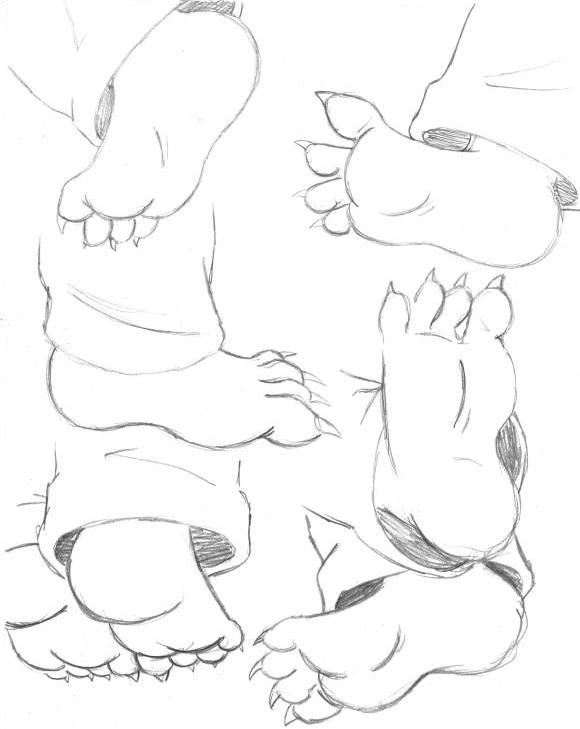
Toma shows us numerous angles
on his style of four-toed, clawed "plush paws" in this drawing - they
are called "plush paws" as they don't have pronounced pads. You can
see the slight asymmetry (the difference between left and right feet
can clearly be seen), the slight wrinkles on the soles and the
expressivity of spreading toes.
Return to the Free Paws page.






